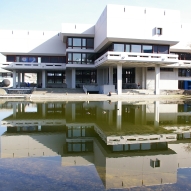| Dokumentenart: | Artikel | ||||
|---|---|---|---|---|---|
| Titel eines Journals oder einer Zeitschrift: | BMC Cancer | ||||
| Verlag: | BMC | ||||
| Ort der Veröffentlichung: | LONDON | ||||
| Band: | 19 | ||||
| Nummer des Zeitschriftenheftes oder des Kapitels: | 1 | ||||
| Datum: | 2019 | ||||
| Institutionen: | Medizin > Zentren des Universitätsklinikums Regensburg > Regensburger Centrum für Interventionelle Immunologie (RCI) | ||||
| Identifikationsnummer: |
| ||||
| Stichwörter / Keywords: | BREAST-CANCER; DIFFERENTIATION ANTIGEN; IDENTIFICATION; MACROPHAGES; EXPRESSION; IMMUNOTHERAPY; LYMPHOCYTES; REGRESSION; DEFICIENT; SECRETION; NY-BR-1; Differentiation antigen; CTL epitope; HLA transgenic mice | ||||
| Dewey-Dezimal-Klassifikation: | 600 Technik, Medizin, angewandte Wissenschaften > 610 Medizin | ||||
| Status: | Veröffentlicht | ||||
| Begutachtet: | Ja, diese Version wurde begutachtet | ||||
| An der Universität Regensburg entstanden: | Ja | ||||
| Dokumenten-ID: | 48258 |

 Web of Science
Web of ScienceZusammenfassung
Background NY-BR-1 has been described as a breast cancer associated differentiation antigen with intrinsic immunogenicity giving rise to endogenous T and B cell responses. The current study presents the first murine tumor model allowing functional investigation of NY-BR-1-specific immune responses in vivo. Methods A NY-BR-1 expressing tumor model was established in DR4tg mice based on heterotopic ...

Zusammenfassung
Background NY-BR-1 has been described as a breast cancer associated differentiation antigen with intrinsic immunogenicity giving rise to endogenous T and B cell responses. The current study presents the first murine tumor model allowing functional investigation of NY-BR-1-specific immune responses in vivo. Methods A NY-BR-1 expressing tumor model was established in DR4tg mice based on heterotopic transplantation of stable transfectant clones derived from the murine H2 compatible breast cancer cell line EO771. Composition and phenotype of tumor infiltrating immune cells were analyzed by qPCR and FACS. MHC I binding affinity of candidate CTL epitopes predicted in silico was determined by FACS using the mutant cell line RMA-S. Frequencies of NY-BR-1 specific CTLs among splenocytes of immunized mice were quantified by FACS with an epitope loaded D-b-dextramer. Functional CTL activity was determined by IFN gamma catch or IFN gamma ELISpot assays and statistical analysis was done applying the Mann Whitney test. Tumor protection experiments were performed by immunization of DR4tg mice with replication deficient recombinant adenovirus followed by s.c. challenge with NY-BR-1 expressing breast cancer cells. Results Our results show spontaneous accumulation of CD8(+) T cells and F4/80(+) myeloid cells preferentially in NY-BR-1 expressing tumors. Upon NY-BR-1-specific immunization experiments combined with in silico prediction and in vitro binding assays, the first NY-BR-1-specific H2-D-b-restricted T cell epitope could be identified. Consequently, flow cytometric analysis with fluorochrome conjugated multimers showed enhanced frequencies of CD8(+) T cells specific for the newly identified epitope in spleens of immunized mice. Moreover, immunization with Ad.NY-BR-1 resulted in partial protection against outgrowth of NY-BR-1 expressing tumors and promoted intratumoral accumulation of macrophages. Conclusion This study introduces the first H2-D-b-resctricted CD8(+) T cell epitope-specific for the human breast cancer associated tumor antigen NY-BR-1. Our novel, partially humanized tumor model enables investigation of the interplay between HLA-DR4-restricted T cell responses and CTLs within their joint attack of NY-BR-1 expressing tumors.
Metadaten zuletzt geändert: 03 Sep 2021 09:45



 Altmetric
Altmetric